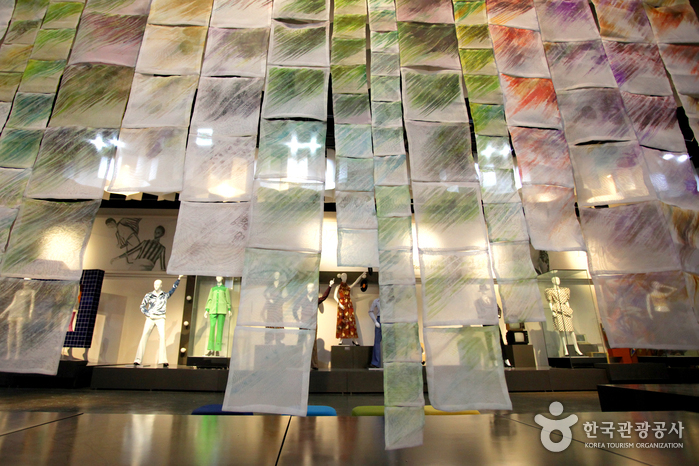Daegu Textile Museum (대구섬유박물관)
10.9Km 2021-03-17
227, Palgong-ro, Dong-gu, Daegu
+82-53-980-1004
Located in Daegu, a city famous for textiles, Daegu Textile Museum is the nation's sole textile musuem. Visitors can learn about the history of fashion, textiles, and related industries through the exhibition halls. The children's experience hall displays clothing from around the world, and offers various hands-on programs and special exhibitions for an informative and fun experience.
Yongyeonsa Temple (Daegu) (용연사(대구))
10.9Km 2024-02-15
260 Yongyeonsa-gil, Okpo-eup, Dalseong-gun, Daegu
The name Yongyeonsa has its roots in a legend: a dragon is said to have ascended from the pond at the temple's entrance, leading to the name Yongyeon ("yong" means "dragon" and "yeon" means "pond" in Korean). This temple is renowned as one of the sites that enshrine the Buddha's sarira (relics). Inside Yongyeonsa, the ordination platform holds special significance as the resting place of the Buddha's sarira, where rituals are conducted. This symbolizes the enduring presence of the Buddha. The approach to Yongyeonsa Temple is through a forest-rich path, offering an experience akin to a forest bathing. This path also doubles as a hiking trail leading up to Biseulsan Mountain.
Egoist - Esiapolis Branch [Tax Refund Shop] (에고이스트 이시아폴리스)
11.0Km 2024-04-17
1F, 16, Palgong-ro 49-gil, Dong-gu, Daegu
-
Daehyun Zooc - Esiapolis Branch [Tax Refund Shop] (대현 주크 이시아폴리스)
11.0Km 2024-04-18
16, Palgong-ro 49-gil, Dong-gu, Daegu
-
Polham - Esiapolis Branch [Tax Refund Shop] (폴햄 이시아폴리스)
11.0Km 2024-04-18
16, Palgong-ro 49-gil, Dong-gu, Daegu
-
Kolon Henry Cotton’s - Esiapolis Branch [Tax Refund Shop] (코오롱 헨리코튼 이시아폴리스)
11.0Km 2024-04-22
16, Palgong-ro 49-gil, Dong-gu, Daegu
-
AK Golf - Esiapolis Branch [Tax Refund Shop] (에이케이골프 이시아폴리스)
11.0Km 2024-04-18
2F, 16, Palgong-ro 49-gil, Dong-gu, Daegu
-
Daehyun Dewl - Esiapolis Branch [Tax Refund Shop] (대현 듀엘 이시아폴리스)
11.0Km 2024-04-18
Daehyun Hall, Lotte Outlet Esia Polis Branch, 16, Palgong-ro 49-gil, Dong-gu, Daegu
-
Tomboy - Esiapolis Branch [Tax Refund Shop] (톰보이 이시아폴리스)
11.0Km 2024-04-18
1F, 16, Palgong-ro 49-gil, Dong-gu, Daegu
-
Uniqlo - Lotte Daegu Bongmu Branch [Tax Refund Shop] (유니클로 롯데봉무)
11.0Km 2024-04-18
16, Palgong-ro 49-gil, Dong-gu, Daegu
-


![Egoist - Esiapolis Branch [Tax Refund Shop] (에고이스트 이시아폴리스)](http://tong.visitkorea.or.kr/cms/resource/67/2888367_image2_1.jpg)
![Daehyun Zooc - Esiapolis Branch [Tax Refund Shop] (대현 주크 이시아폴리스)](http://tong.visitkorea.or.kr/cms/resource/62/2888562_image2_1.jpg)
![Polham - Esiapolis Branch [Tax Refund Shop] (폴햄 이시아폴리스)](http://tong.visitkorea.or.kr/cms/resource/98/2888898_image2_1.jpg)
![Kolon Henry Cotton’s - Esiapolis Branch [Tax Refund Shop] (코오롱 헨리코튼 이시아폴리스)](http://tong.visitkorea.or.kr/cms/resource/92/2888992_image2_1.jpg)
![AK Golf - Esiapolis Branch [Tax Refund Shop] (에이케이골프 이시아폴리스)](http://tong.visitkorea.or.kr/cms/resource/41/2889041_image2_1.jpg)
![Daehyun Dewl - Esiapolis Branch [Tax Refund Shop] (대현 듀엘 이시아폴리스)](http://tong.visitkorea.or.kr/cms/resource/43/2889043_image2_1.jpg)
![Tomboy - Esiapolis Branch [Tax Refund Shop] (톰보이 이시아폴리스)](http://tong.visitkorea.or.kr/cms/resource/13/2889213_image2_1.jpg)
![Uniqlo - Lotte Daegu Bongmu Branch [Tax Refund Shop] (유니클로 롯데봉무)](http://tong.visitkorea.or.kr/cms/resource/11/2889311_image2_1.jpg)
 English
English
 한국어
한국어 日本語
日本語 中文(简体)
中文(简体) Deutsch
Deutsch Français
Français Español
Español Русский
Русский